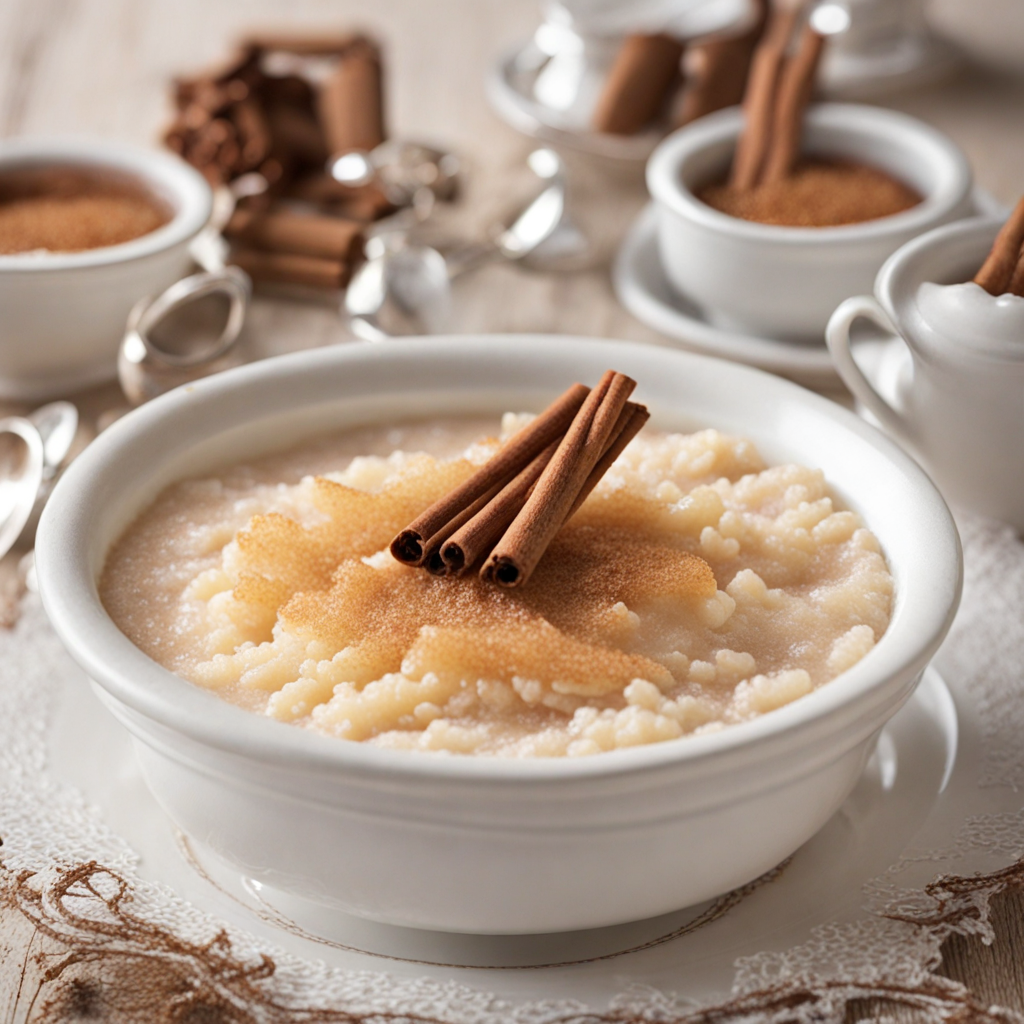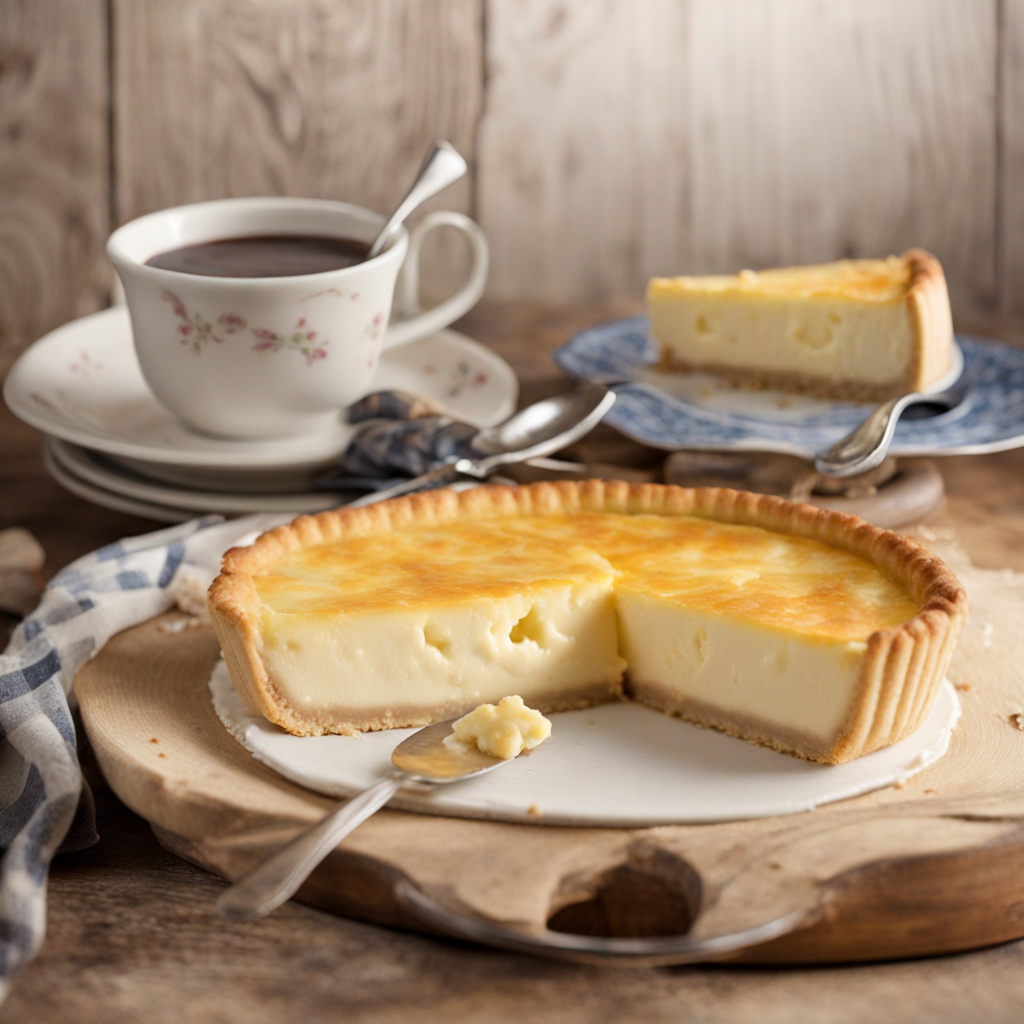Swedish Rice Pudding
Swedish Rice Pudding, known as "Risgrynsgröt," is a comforting and creamy dish that embodies the essence of Swedish cuisine. Made primarily from short-grain rice, milk, sugar, and a hint of salt, this pudding is slowly simmered to achieve a luscious texture that is both rich and satisfying. The rice absorbs the milk, becoming tender and plump, while the gentle sweetness makes it an ideal treat for both breakfast and dessert. Often, a dusting of cinnamon or a drizzle of cold milk is added before serving, elevating its comforting nature with warm, aromatic spices. Traditionally, Swedish Rice Pudding is often enjoyed during the festive season, particularly around Christmas. It is commonly served with a hidden almond inside, a fun tradition where the person who finds the almond is said to have good luck for the coming year. The dish is frequently accompanied by a tart fruit compote, such as lingonberry, which adds a delightful contrast to the creamy sweetness of the pudding. This combination not only enhances the flavor profile but also adds a vibrant splash of color to the plate. The versatility of Risgrynsgröt allows it to be enjoyed in various ways, whether served warm or cold. Some people prefer it chilled, topped with fresh berries or a dollop of whipped cream, while others enjoy it hot with a sprinkle of sugar. No matter how you choose to indulge, Swedish Rice Pudding offers a taste of nostalgia and warmth, making it a beloved staple in Swedish households and a delightful discovery for anyone looking to explore new flavors.
How It Became This Dish
The Engaging History of Risgrynsgröt: Sweden's Beloved Rice Porridge Risgrynsgröt, a creamy rice porridge, holds a cherished place in Swedish culinary tradition. This simple yet delightful dish is more than just food; it is a symbol of warmth, comfort, and cultural significance, deeply embedded in the fabric of Swedish life. Its journey through history reflects broader societal changes, regional variations, and the evolution of food practices in Sweden. #### Origins The roots of Risgrynsgröt can be traced back to the Middle Ages when rice was introduced to Europe through trade routes from Asia. Initially, rice was a luxury item, primarily enjoyed by the wealthy. However, as trade expanded and agricultural practices evolved, rice became more accessible to the general population. The earliest recipes for rice porridge likely appeared in various European countries, each adapting the dish according to local ingredients and tastes. In Sweden, rice was not widely cultivated until the 18th century, but it gained popularity due to its versatility and ability to provide sustenance during long winters. The first documented references to Risgrynsgröt appear in Swedish cookbooks from the 19th century, but it is believed that the dish was enjoyed long before then, passed down through generations as a staple food. #### Cultural Significance Risgrynsgröt is traditionally associated with festive occasions, particularly during Christmas. In Sweden, it is customary to serve this dish on Christmas Eve as part of the holiday meal. The creamy porridge is often enhanced with a sprinkle of cinnamon and a touch of sugar, and it is sometimes served with a dollop of berry sauce, typically lingonberry or cloudberry. One of the most delightful traditions surrounding Risgrynsgröt is the hiding of an almond within the porridge. The person who finds the almond is said to be blessed with good fortune for the coming year. This playful custom adds an element of anticipation and joy to the meal, reinforcing the bond between family and friends as they gather around the table during the holiday season. Beyond Christmas, Risgrynsgröt is enjoyed throughout the winter months, providing warmth and comfort during the cold Swedish climate. It is a dish that evokes nostalgia, often reminding Swedes of their childhood, when they would enjoy the creamy porridge prepared by their parents or grandparents. Many families have their own cherished recipes, passed down through generations, each with its unique touch. #### Development Over Time As with many traditional dishes, Risgrynsgröt has evolved over the years, incorporating new ingredients and methods of preparation. The basic recipe consists of short-grain rice, milk, sugar, and a pinch of salt. Over time, variations have emerged, influenced by regional tastes and available ingredients. In the early 20th century, as Swedish society became increasingly urbanized, the convenience of pre-packaged foods began to change how Risgrynsgröt was prepared. Instant rice and pre-mixed porridge blends made the dish easier to prepare, leading to a decline in traditional cooking methods. However, the rise of the Slow Food movement and an increasing interest in traditional and sustainable food practices have rekindled a love for homemade Risgrynsgröt. Modern interpretations of the dish often include additional flavors and ingredients. Chefs and home cooks alike experiment with coconut milk for a dairy-free version, or infuse the porridge with spices such as cardamom or vanilla for a contemporary twist. Some variations even incorporate fruits or nuts, broadening the scope of this classic dish and appealing to a wider audience. #### Risgrynsgröt Today Today, Risgrynsgröt enjoys a revived popularity, not just in Sweden but also among Swedish diaspora communities worldwide. It has been embraced as a comfort food that transcends generations, connecting people to their heritage and culture. In Sweden, it is often found on the menus of cafés and restaurants, especially during the winter months. Moreover, the dish has gained recognition in the broader context of Scandinavian cuisine, which has been celebrated for its emphasis on simplicity, quality ingredients, and seasonal flavors. As the global interest in Nordic food continues to rise, Risgrynsgröt stands as a testament to the enduring appeal of traditional dishes that evoke feelings of home and belonging. In the digital age, social media has played a significant role in the resurgence of interest in Risgrynsgröt. Food bloggers and influencers share their recipes, often accompanied by beautiful photographs that highlight the dish's creamy texture and comforting appearance. This visibility has inspired a new generation to embrace traditional Swedish cooking, ensuring that Risgrynsgröt remains a beloved dish for years to come. #### Conclusion Risgrynsgröt is more than just a simple rice porridge; it is a reflection of Sweden's rich culinary heritage, cultural identity, and familial bonds. Its origins, rooted in the introduction of rice to Europe, have grown into a beloved dish that embodies the warmth of Swedish hospitality, particularly during the winter months and festive occasions. As Risgrynsgröt continues to evolve, adapting to modern tastes and trends while retaining its traditional essence, it remains a symbol of comfort and connection. Whether enjoyed on a cold winter's night or as part of a festive feast, Risgrynsgröt is a dish that tells the story of Sweden—its history, culture, and the enduring importance of food in bringing people together.
You may like
Discover local flavors from Sweden







